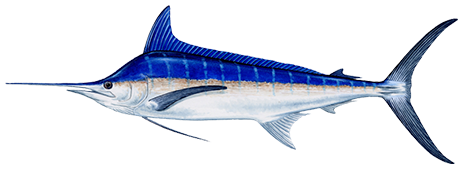Blue Marlin

Blue Marlin
Japanese longliners report that blue marlin is the largest of the istiophoriod fishes. It apparently grows larger in the Pacific.
HOW TO IDENTIFY A BLUE MARLIN
All giant marlins are females, and male blue marlin are never completely rigid, even after death, and can be folded completely flat against the sides except in the largest specimens. The dorsal fin is high and pointed anteriorly (rather than rounded) and its greatest height is less than the greatest body depth. The anal fin is relatively large and it too is pointed. Juveniles may not share all the characteristics listed above, but the peculiar lateral line system is usually visible in small specimens. In adults it is rarely visible unless the scales or skin are removed. The vent is just in front of the anal fin, as it is in all billfish except the spearfish. The back is cobalt blue and the flanks and belly are silvery white. There may be light blue or lavender vertical stripes on the sides, but these usually fade away soon after death, and they are never as obvious as those of the striped marlin. There are no spots on the fins.
WHERE TO CATCH BLUE MARLIN
This pelagic and migratory species occurs in tropical and warm temperate oceanic waters. In the Atlantic Ocean it is found from 45 degrees North to 35 degrees South, and in the Pacific Ocean from 48 degrees North to 48 degrees South. It is less abundant in the eastern portions of both oceans. In the Indian Ocean it occurs around Ceylon, Mauritius, and off the east coast of Africa. In the northern Gulf of Mexico its movements seem to be associated with the so called Loop Current, an extension of the Caribbean Current. Seasonal concentrations occur in the southwest Atlantic (5 degrees to 30 degrees South) from January to April; in the northwest Atlantic (10 degrees to 35 degrees North) from June to October; in the western and central North Pacific (10 degrees North to 10 degree South) in April and November; and in the Indian Ocean (0 degrees to 13 degrees South) from April to October. The following list includes additional details on where to catch this fish:
Baitfish Patches Deep Shore Water
Floating Foam and Debris Merging Water
Night Fishing
HOW TO CATCH BLUE MARLIN
They are known to feed on squid and pelagic fishes, including blackfin tuna and frigate mackerel. A powerful, aggressive fighter, they run hard and long, sound deep, and leap high into the air in seemingly inexhaustible display of strength. Fishing methods include trolling large whole baits such as bonito, dolphin, mullet, mackerel, bonefish, ballyhoo, flying fish and squid as well as various types of artificial lures and sometimes strip baits. The following are fishing methods used to catch this fish:
Saltwater Trolling